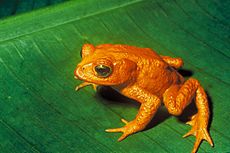NatureServe conservation status facts for kids
Quick facts for kids Conservation status
|
|
|---|---|
 |
|
| Extinct | |
|
|
| Threatened | |
|
|
| Lower Risk | |
|
|
|
Other categories |
|
|
|
|
Related topics
|
|
 Comparison of Red list classes above and NatureServe status below  |
|
The NatureServe conservation status system helps us understand how safe or endangered different species of plants, animals, and even natural areas (called ecological communities) are. It was created in the United States in the 1980s by an organization called NatureServe. This system gives a special rank to each species or community. These ranks tell us if they are doing well or if they need our help to survive. NatureServe works with many groups to keep this information updated.
These ranks focus on species and communities living in their natural homes. They don't count animals in zoos or plants grown in gardens. They also don't count species that were brought to a new place by people, like some invasive species.
Most NatureServe ranks are for species in the United States and Canada. However, this system can be used anywhere in the world. You can find all these ranks on the NatureServe Explorer website. It's like a big online library of conservation information.
Contents
Protecting Our Planet: Understanding NatureServe Ranks
NatureServe uses a simple system to show how safe or endangered a species or natural area is. Most ranks use a number from 1 to 5. Number 1 means it's in the most danger, and 5 means it's very safe. Sometimes, letters are used instead of numbers for special situations. These ranks can apply to the whole world, a country, or even a smaller area like a state.
Global, National, and Local Ranks
NatureServe ranks can tell us about a species' status at different levels:
- G-rank (Global): This rank tells us how a species is doing all over the world.
- N-rank (National): This rank shows its status within a specific country, like Canada or the United States.
- S-rank (Subnational): This rank looks at a species' status in a smaller area, like a state or province.
How NatureServe Ranks Species and Habitats
NatureServe uses numbers and letters to give a clear picture of a species' health. Let's look at what these ranks mean:
Understanding the Numbers: From 1 to 5
- 1 — Critically Imperiled: These species are in extreme danger. There are very few of them left, or they live in only a few places. They need urgent help.
- 2 — Imperiled: These species are also in great danger. They have few remaining individuals or live in a limited number of places. They face serious threats.
- 3 — Vulnerable: These species are rare. They might have a moderate number of individuals or occurrences. They could become more endangered if threats increase.
- 4 — Apparently Secure: These species are uncommon but not rare. They are generally safe, but there might be some concerns for their future. They are watched carefully.
- 5 — Secure: These species are common and widespread. They have many individuals and are not facing major threats. They are doing very well.
Special Letters: What They Mean
- X (Presumed Extinct or Extirpated): This means a species is believed to be gone forever. 'Extinct' means gone from the whole world. 'Extirpated' means gone from a specific country or area, but still alive elsewhere.
- H (Possibly Extinct or Extirpated): This means a species has not been seen for a long time. There is still a small hope it might be rediscovered.
- R or ? (Status Unknown): This means we don't have enough information to give a clear rank. More research is needed.
- T (Subspecies or Varieties): This rank is used for smaller groups within a species, like different types of a plant. It's added to the main species' rank.
- E (Non-Native): This rank is for species that are not naturally found in an area. They were brought there by people, either on purpose or by accident.
- HYB (Hybrids): This rank is for species that are a mix of two different species. They usually don't get a full conservation rank unless they form their own stable populations.
- C (In Captivity or Cultivation): This letter is added to X or H ranks. It means the species is gone from the wild but still exists in zoos or gardens.
- G2G3 (Range of Ranks): Sometimes, scientists are not completely sure of a species' exact rank. They might give a range, like G2G3, meaning it's somewhere between imperiled and vulnerable globally.
- U (Unrankable): This means there isn't enough reliable information to give a rank.
- NR (Not Ranked): This means the species has not yet been evaluated by NatureServe.
- NA (Not Applicable): This rank is used for things that don't fit the conservation system. For example, a farm field is not a natural ecosystem.
For example, a species ranked G3 is "globally vulnerable." An N2 species is "nationally imperiled" in its country. Species with ranks of 4 or 5 usually don't need major conservation efforts.
Combining Ranks for a Full Picture
NatureServe ranks can be combined to give a very detailed picture. For example, a rank might look like G5N3S1. This means:
- G5: The species is globally secure (doing well worldwide).
- N3: It is nationally vulnerable (rare in a specific country).
- S1: It is critically imperiled in a particular state or province.
A species has only one global rank. But it can have different national or subnational ranks depending on where it lives.
See also
- Conservation status
- Listing priority number

